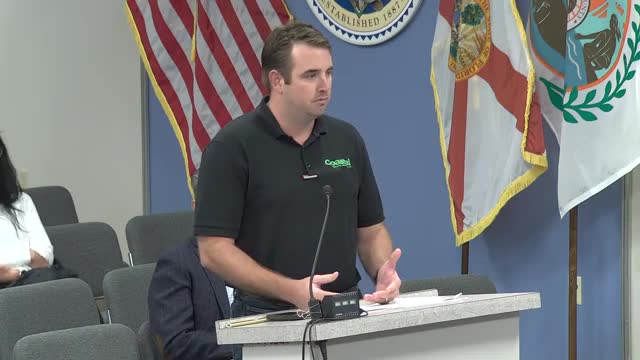Commissioners reject density increase for proposed residential development project
January 03, 2025 | Citrus County, Florida
This article was created by AI summarizing key points discussed. AI makes mistakes, so for full details and context, please refer to the video of the full meeting. Please report any errors so we can fix them. Report an error »

In the heart of Citrus County, Florida, the Planning and Development Commission convened on January 2, 2025, to address a contentious development proposal that has sparked significant debate among local officials and residents alike. As the meeting unfolded, the atmosphere was charged with concern over the implications of increased density in a community already grappling with growth challenges.
The proposal under scrutiny sought to increase residential density to four units per acre, a move that some commissioners viewed as a necessary transition, while others expressed deep reservations. One commissioner emphasized the importance of thoughtful planning, noting that the development would be privately funded and not reliant on special districts or community development districts. However, this assurance did little to quell the concerns raised about the potential impact on local infrastructure and community character.
A key moment in the meeting came when Mr. Dixon, a planner from the school board, voiced his apprehensions regarding the project. He highlighted that the proposed density could exacerbate existing issues at the nearby Rock Crusher School, which is already planning for expansions to accommodate a growing student population. Dixon argued that the planned development, primarily consisting of single-family homes, lacked the diversity of land uses typically associated with a Planned Development Residential (PDR) designation. He cautioned that simply increasing density without a corresponding variety of housing types could lead to a mismatch with the surrounding community.
Commissioner Brandt echoed these sentiments, expressing skepticism about the compatibility of the proposed density with the existing low-density residential zoning. He pointed out that while the applicant claimed to be seeking less density than what could be allowed, the reality was that the project would still significantly increase the number of homes in an area already facing congestion. Brandt's concerns were rooted in personal experience, as he noted the crowded conditions on local roads, which he felt were not conducive to further development.
As the discussion progressed, it became clear that the economic motivations behind the proposal were a double-edged sword. While the need for affordable housing was acknowledged, several commissioners argued that economic pressures should not override the fundamental principles of good planning and community compatibility. Commissioner Worthegan reinforced this perspective, stating that the proposal felt more aligned with medium-density residential standards rather than the low-density character of the area.
As the meeting drew to a close, the commissioners were left grappling with the challenge of balancing economic needs with the preservation of community integrity. The outcome of this proposal remains uncertain, but the discussions highlighted a critical juncture for Citrus County as it navigates the complexities of growth and development in a rapidly changing landscape. The voices of local officials and residents will undoubtedly continue to shape the future of their community as they seek to find a path that honors both progress and preservation.
The proposal under scrutiny sought to increase residential density to four units per acre, a move that some commissioners viewed as a necessary transition, while others expressed deep reservations. One commissioner emphasized the importance of thoughtful planning, noting that the development would be privately funded and not reliant on special districts or community development districts. However, this assurance did little to quell the concerns raised about the potential impact on local infrastructure and community character.
A key moment in the meeting came when Mr. Dixon, a planner from the school board, voiced his apprehensions regarding the project. He highlighted that the proposed density could exacerbate existing issues at the nearby Rock Crusher School, which is already planning for expansions to accommodate a growing student population. Dixon argued that the planned development, primarily consisting of single-family homes, lacked the diversity of land uses typically associated with a Planned Development Residential (PDR) designation. He cautioned that simply increasing density without a corresponding variety of housing types could lead to a mismatch with the surrounding community.
Commissioner Brandt echoed these sentiments, expressing skepticism about the compatibility of the proposed density with the existing low-density residential zoning. He pointed out that while the applicant claimed to be seeking less density than what could be allowed, the reality was that the project would still significantly increase the number of homes in an area already facing congestion. Brandt's concerns were rooted in personal experience, as he noted the crowded conditions on local roads, which he felt were not conducive to further development.
As the discussion progressed, it became clear that the economic motivations behind the proposal were a double-edged sword. While the need for affordable housing was acknowledged, several commissioners argued that economic pressures should not override the fundamental principles of good planning and community compatibility. Commissioner Worthegan reinforced this perspective, stating that the proposal felt more aligned with medium-density residential standards rather than the low-density character of the area.
As the meeting drew to a close, the commissioners were left grappling with the challenge of balancing economic needs with the preservation of community integrity. The outcome of this proposal remains uncertain, but the discussions highlighted a critical juncture for Citrus County as it navigates the complexities of growth and development in a rapidly changing landscape. The voices of local officials and residents will undoubtedly continue to shape the future of their community as they seek to find a path that honors both progress and preservation.
View full meeting
This article is based on a recent meeting—watch the full video and explore the complete transcript for deeper insights into the discussion.
View full meeting